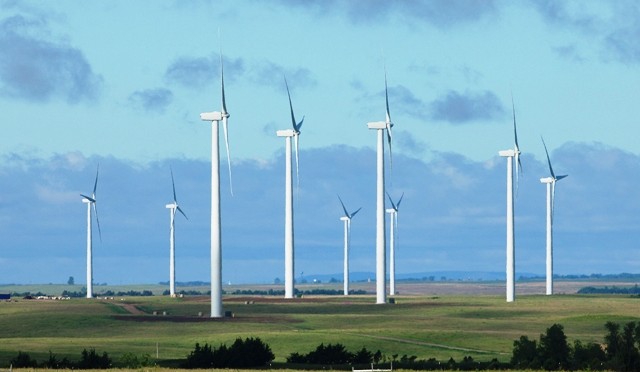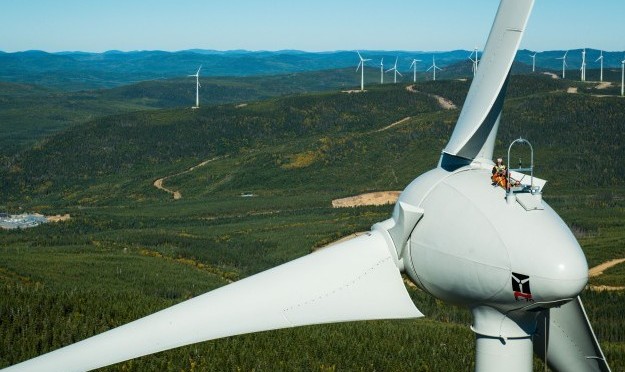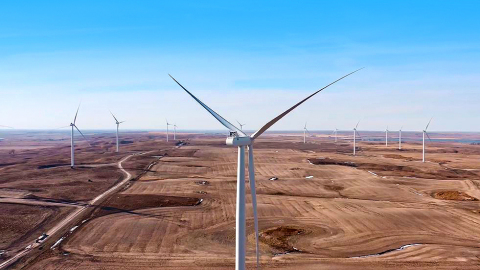Trump has already declared his hatred of wind energy by spreading lies and falsehoods again and again. As for photovoltaics, tariffs on imports from China will make their installation more expensive.

With the recent election of Donald Trump as president, the future of energy and climate policies in the US is once again under scrutiny. The election results cast a shadow over previous progress made towards cleaner energy sources, raising the question of what’s next for the renewable energy sector.
Investments across clean energy sectors surged over the past few years, fulfilling promises made to create jobs and promote sustainable alternatives to fossil fuels. The SEIA predicts this trend could continue, stating during member briefings following the election, “Who is in control of Congress and the White House has direct impacts on our industry…” After holding onto energy credits from the Inflation Reduction Act, the industry had seen its innovative projects take off, but the mood shifted dramatically post-election.
Trump, emphasizing energy independence and competitiveness, has voiced intentions to increase domestic fossil fuel production, reinstate natural gas pipelines, and streamline drilling processes on federal land. Crucially, he has suggested pulling the U.S. out of international agreements like the Paris Climate Accord, which many environmentalists view as detrimental to global climate commitments. Recent analyses indicate immediate fallout, stating, “Solar and wind energy stocks fell sharply after the election result.” This drop signals investors’ concerns about the long-term viability of green energy under the Trump administration.
Despite these mixed signals, some analysts note the renewable energy boom is unlikely to halt entirely. For one, considerable financial backing from existing programs remains, and many Republican factions might oppose drastic cuts to wind and solar initiatives during Trump’s tenure, as his term coincides with significant shifts toward sustainable practices.
Across various data and reports, there are indications of resilience among renewable energy stakeholders. The outgoing administration’s initiatives, like the Inflation Reduction Act, infused about $1 trillion to spur growth and adaptation within the energy sector, particularly for solar power. Reports suggest 85% of funding has favored Republicans’ congressional districts, indicating bipartisan support for renewable energy investments.
At the same time, the rhetoric surrounding the upcoming government direction raises eyebrows. With Trump pushing for increased output from coal, oil, and gas, the question arises: can the renewable sector sustain growth amid opposing political winds? Some experts suggest the fossil fuel outlook might not change significantly, positing, “US fossil fuel production is likely to look much the same under Trump.” This statement points to the established reality of the U.S. as the world’s largest oil and gas producer due to operational programs set previously.
Another thread connected to Trump’s presidency is the convergence of global energy dynamics. His administration’s influence extends beyond national borders as global markets watch closely. The question this poses is whether the U.S. will pivot boldly back to fossil fuels entirely, potentially triggering international energy market disruptions.

The situation leaves the future of climate action unclear. Many industry advocates worry about the possibility of losing momentum gained within the renewable sector. Despite fears, clean energy investments may very well continue on this upward trend, albeit with some turbulence along the way. Industry experts and stakeholders within the renewable energy community are now left piecing together their strategy with the government’s shifting policies.
Meanwhile, as discussions around energy policy remain hot topics, scientific communities continue emphasizing clean transitions through infrastructure enhancements and practical applications of renewable resources. Moving forward will require balancing traditional energy methods with innovative solutions to cater to both economic and environmental concerns.
With the new election results shaping the next presidential term, the energy industry is filled with anticipation about how lawmakers will engage with new challenges and the political discourse surrounding energy use and production. With wider conversations like the economic performance of solar energy, supporters remain hopeful about forging new political landscapes and innovation to realize clean energy futures.
Trump has vowed to kill US offshore wind projects. Will he succeed?
Opponents of offshore wind energy projects expect President-elect Donald Trump to kill an industry he has vowed to end on the first day he returns to the White House.
Many of the largest offshore wind companies put a brave face on the election results, pledging to work with Trump and Congress to build power projects and ignoring the incoming president’s oft-stated hostility to them.
In campaign appearances, Trump railed against offshore wind and promised to sign an executive order to block such projects.
“We are going to make sure that that ends on Day 1,” Trump said in a May speech. “I’m going to write it out in an executive order. It’s going to end on Day 1.”
“They destroy everything, they’re horrible, the most expensive energy there is,” Trump said. “They ruin the environment, they kill the birds, they kill the whales.”
Numerous federal and state scientific agencies say there is no evidence linking offshore wind preparation to a spate of whale deaths along the U.S. East Coast in recent years. Turbines have been known to kill shorebirds, but the industry and regulators say there are policies to mitigate harm to the environment.
Trump has railed against offshore wind turbines spoiling the view from a golf course he owns in Scotland. But numerous environmental groups say the real reason he opposes offshore wind is his support for the fossil fuel industry.
There is almost 65 gigawatts of offshore wind capacity under development in the U.S., enough to power more than 26 million homes, and some turbines are already spinning in several states, according to the American Clean Power Association.
Currently operating projects include the Block Island Wind Farm in Rhode Island, the Coastal Virginia Offshore Wind pilot project and the South Fork Wind Farm about 35 miles (56 kilometers) east of Montauk Point on New York’s Long Island.
Trump is unlikely to end those projects but might have more leverage over ones still in the planning stage, those in the debate say.
Bob Stern, who headed an office in the U.S. Energy Department responsible for environmental protection during the Ford, Carter and Reagan administrations, said Trump can get Congress to reduce or eliminate tax credits for offshore wind that were granted in the Biden administration’s Inflation Reduction Act. Those credits are an integral part of the finances of many offshore wind projects.
Stern, who leads the New Jersey anti-offshore wind group Save LBI, said Trump also could issue executive orders prohibiting further offshore leases and rescinding approval for ones already approved while pushing Congress to amend federal laws granting more protection for marine mammals.
The president-elect also can appoint leaders of agencies involved in offshore wind regulation who would be hostile to it or less supportive.
Opponents of offshore wind, many of them Republicans, were giddy following the election, saying they fully expect Trump to put an end to the industry.
“I believe this is a tipping point for the offshore wind industry in America,” said Robin Shaffer, president of Protect Our Coast NJ, one of the most vocal groups opposing offshore wind on the East Coast. “They have been given a glidepath by Democrat-run administrations at the federal and state level for many years. For this industry, (Tuesday’s) results will bring headwinds far greater than they have faced previously.”
But Tina Zappile, director of the Hughes Center for Public Policy at New Jersey’s Stockton University, noted that in 2018, Trump Interior Secretary Ryan Zinke voiced strong support for offshore wind. And even though the president-elect has bashed the technology, she predicted he won’t just make it go away.
“Offshore wind might appear to be on the chopping block — Trump’s explicitly said this was something he’d fix on the first day — but when the economics of offshore wind are in alignment with his overall strategies of returning manufacturing to America and becoming energy-independent, his administration is likely to back away slowly from this claim,” she said in an interview. “Offshore wind may be temporarily hampered, but its long-term prospects in the U.S. are unlikely to be hurt.”
Commercial fishermen in Maine said they hope the Trump administration will undo policies designed to help build and approve offshore wind projects, saying regulators attempted to “future-proof” the industry against political change. Jerry Leeman, CEO of the New England Fishermen’s Stewardship Association, called on Trump to reverse a commitment to deploy 30 gigawatts of offshore wind by 2030.
The offshore wind industry is taking an optimistic stance, pledging to work with Trump his political allies. National and New Jersey wind industry groups, and several offshore wind developers including Atlantic Shores and Denmark-based Orsted, issued similarly worded statements highlighting terms likely to appeal to Republicans including job creation, economic development and national security.
“By combining the strengths of all domestic energy resources, the Trump administration can advance an economy that is dynamic, secure, and clean,” Jason Grumet, CEO of the American Clean Power Association, said in a statement. “We are committed to working with the Trump-Vance administration and the new Congress to continue this great American success story.”
But few Republicans were in a welcoming mood following the election. New Jersey Assemblyman Paul Kanitra listed the major offshore wind companies in a Facebook post, saying, “It’s time to pack your bags and get the hell away from the Jersey Shore, our marine life, fishing industry and beautiful beaches.”
Kanitra said he was looking forward “to your stock prices tanking.” And that was starting to happen.
The stock prices of European offshore wind companies, many of which are planning or building projects on the U.S. East Coast, plunged amid fears the new administration would seek to slow or end such projects. Orsted closed down nearly 14% on Wednesday and was down 11% over the past five days. Turbine manufacturer Vestas Wind Systems was down nearly 24% over that same period.
Rep. Jeff Van Drew, a New Jersey Republican, hosted Trump at a rally earlier this year at which Trump again vowed to kill offshore wind.
“We are currently working out the specifics of what that will look like once he takes office again this January,” VanDrew said. “President Trump is a good friend of New Jersey, and he understands the devastating impact these projects will have on our communities.”




